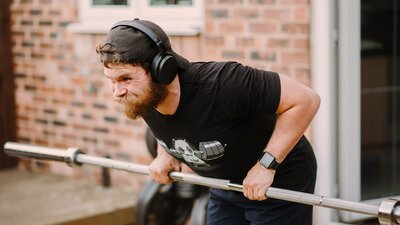Let’s teach you the techniques and cues to help you master the bent-over row. This exercise is exceptional at building postural stability, back strength, and back hypertrophy (1). The bent-over row is an exercise in the “pull family,” a diverse, back and arm dominant movement pattern (for example, pull-downs, seated rows, pull-ups, etc) that has its place in any program.
The bent-over row may seem simple, but valuable techniques, such as the hip hinge, can carry over into the rest of your training program. This article will focus on the conventional barbell bent-over row technique. However, these techniques can still apply to other row variations or pulls. Let’s analyze how implementing these techniques will make your row seamless and improve your whole body through core stability and overall body awareness.
Set-Up
If you can do a Romanian deadlift, you can set up well for the barbell row. Both exercises require a hip hinge, a neutral spine, and a stable core. The hand position (overhand or underhand) depends on preference and the muscles you want to emphasize. Grip width should be slightly more than shoulder width apart.
Begin by standing tall with the barbell, then slowly hinge your hips back. Beginning this way, rather than rowing from the floor the first rep, allows time to build more tension in the body as you hinge down. The further you can hinge the hips, the greater the range of motion you will have to perform the row. Being too upright also puts less emphasis on the lats and more on the shoulders and biceps.
Once the hips have hinged, go through these checkpoints to ensure stability:
Create tension in your feet by grabbing the floor with your toes
Drive the knees out laterally by contracting the gluteus medius
Maintain a neutral spine, including the neck, by looking at the floor, not up at a mirror
Tighten your abdominals
Pull the shoulder blades down and back
Ascent and Descent
The only joints that should move are the elbow and shoulder joints. Every other joint should remain stable, especially the spine and scapulothoracic (shoulder blade) joints. This follows the principle of “proximal stability and distal mobility,” in which stability is created in the core to allow the muscles of the extremities to produce force.
With the arms fully extended and the shoulder blades pulled back, begin rowing the bar by
Drive the elbows towards the ceiling
Keep the bar close to the legs
Pull the bar into your belly button or slightly below
One common mistake when lowering the bar is to roll the shoulders forward. Here are a couple more cues to keep in mind:
Keep the elbows pointed behind you, not flared out to the sides
Squeeze the lats on the concentric movement (way up)
Imagine your biceps and forearms are numb so you can only move the bar with the lats
Outro
From the initial setup to the subsequent descent and ascent, the importance of core, hip, and shoulder stability cannot be overstated. As you implement these principles into your training, focus on the details from the ground up, from your foot activation to the tension in your lats.
When using these techniques, you’ll avoid most mistakes, and the weight will move seamlessly. Optimizing stability throughout the movement makes the difference for maximal strength and joint longevity.
Your understanding of the bent-over row technique has grown, so lift confidently!
Sources
- Fenwick CM, Brown SH, McGill SM. Comparison of different rowing exercises: trunk muscle activation and lumbar spine motion, load, and stiffness. J Strength Cond Res. 2009 Mar;23(2):350-8. doi: 10.1519/JSC.0b013e3181942019. PMID: 19197209.

